Jordan has been constantly settled throughout every single period of history since 9500 BC. It has always been a critical land bridge between Africa, Asia, Europe & Its neighbors, the great civilizations of the ancient world, have always sought to control it. The multitudes of civilizations that have passed through, or settled here, have each left their individual mark on the country – evidence of the rich heritage that Jordan enjoys today.
Jordan has been graced with a rich religious history; Located between Mecca and Jerusalem, played a central role in history of Ahl- Ul-Kitab (People of the Book /Jews and Christians). Many early Abrahamic prophets mentioned in the Old Testament, Bible and Holy Qur'an are associated with Jordan; they either lived in or travelled through its land.It is believed that the land of modern Jordan forms part of the “blessed neighborhood” mentioned in the Holy Qur'an(Sura 17,verse 1)
Mecca gave political and religious recognition to the growing community of Muslims.
At the conquest of Jerusalem, he was one of the Muslim signatories. Abdul-Rahman was a successful businessman who shared his wealth. On one day he managed to free 31 slaves, another time he gave a caravan of 700 camels loaded with food to charity and upon his death he made a charitable will of 1000 horses and 50,000 dinars.
Kerak Shrines (Tombs of the martyrs of Mutah Battle)
The most significant and fiercest battle fought during Prophet Mohammad’s
(PBUH) lifetime was the Battle of Mutah (629 AD).
It took the lives of his closest companions, martyred fighting against a combined Byzantine/Ghassanid army. You can visit the tombs of the venerable companions Zaid bin Harithah, Ja'far bin Abi Talib, and Abdullah bin Ruwahah, in the town of Al-Mazar Al-Janubi, near Kerak.
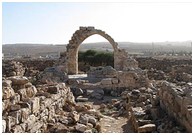
The Prophet (sallallahu `alayhi wa sallam) had sent Harith b. ‘Umayr al-Azdi to deliver his letter to Sharhbil b. ‘Amr al-Ghassani, a satrap of the Byzantine Emperor at Busara. Harith was first tied up under the orders of Sharhbil and then beheaded. However disagreeable a message was conveyed by an emissary, it had never been the custom of kings to condemn the envoys to death sentence. The crime was disgraceful both for the sender of the letter and the addressee as well as it poses a grave danger to the envoys, and could not just assume impunity or ever allowed to go unpunished. The guilt of blood had to be avenged with firmness so that no tyrant would be tempted to repeat a similar crime in the future, The Prophet (sallallahu `alayhi wa sallam) decided to send a detachment to Busra in Jamada
Al-Ula, 8 A.H, A force 3,000 strong was drafted. It was the strongest force sent out so far and a number of leading companions had enlisted for active service, but the Prophet (sallallahu `alayhi wa sallam) entrusted the expedition to his freed slave Zayd (radiallahu 'anhu) b. Haritha. He instructed that if Zayd (radiallahu 'anhu) will be killed then J'afar (radiallahu 'anhu) b. Abu Talib should take over the command, and if the latter meets the same fate, then the mandate should pass on to ‘Abdullah b. Rawaha. When the expedition was already prepared to leave, the people bade farewell and saluted the commanders selected by the Prophet (sallallahu `alayhi wa sallam). The force had to undertake a long and arduous journey in order to face an enemy backed by the strongest empire of the world.

Zayd ibn Harithah 
(Arabic: زيد بن حارثة) or Zayd mawla Muhammad (c. 588-629 CE),
Was a prominent figure in the early Islamic community and the only one of sahaba whose name appears in the Qur'an (33:37).He was the adopted son of the prophet
(sallallahu `alayhi wa sallam). He was the 01st leader who killed during the battle.
Ja‘far ibn Abī Tālib 
(Arabic: جعفر ابن أبي طالب) (Died 629), also known as Ja‘far at-Tayyār, was the son of Abu Talib ibn 'Abdul Muttalib (the uncle of prophet
(sallallahu `alayhi wa sallam)), and the elder brother of the fourth Islam caliph, Ali ibn Abi Talib. Jafar was raised by his uncle, Abbas ibn 'Abdul Muttalib, for his father was a poor man and had to support a big family. He embraced Islam in around 613. He appointed Zayd ibn Harithah as commander of the army and he was subsequently killed during the battle.

Abdullah ibn Rawahah ibn Tha‘labah 
(Arabic: عبدالله ابن رواحة) was one of the companions of the prophet
(sallallahu `alayhi wa sallam), He was one of the twelve representatives of the Ansar who took an oath of allegiance initially, before the Hijra and later spread Islam to Medina. Also he was among the 73 that pledged allegiance to the prophet (sallallahu `alayhi wa sallam) in Medina; Abd Allah ibn Rawahah was third in command during the Battle of Mu'tah and was subsequently killed during the battle.
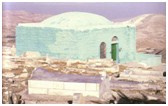
Shrine of prophet NUH (NOAH)
- Kerak city
Other shrines of significance to Islam are located in Kerak city. You can visit Prophet Nuh ‘Noah’ shrine, Allah
sent Noah
to his people to warn them of divine punishment if they continued to worship idols. As stated in the Holy Qur'an in a Sura entitled Noah (Sura 71, verses 1-3): "We sent Noah to his People (with the Command): Do thou warn thy People before there comes to them a grievous Chastisement. He said: O my People! I am to you a Warner, clear and open: That ye should worship Allah, fear Him and obey me".
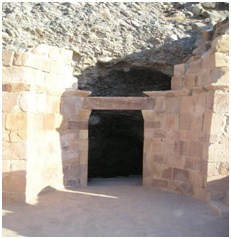
Prophet Lut
- (SODOM AND GOMORRAH (Dead Sea))
The Prophet Lut
lived at the same time as the Prophet Ibrahim
and was sent as a Messenger to a neighboring tribe to the Prophet Ibrahim
That tribe, according to the Qur'an, practiced a perversion never before seen in
the world: homosexuality. When the Prophet Lut
told the people to abandon one of the greatest sins and delivered to them the message
of Allah, they rejected him. They denied that he was a Prophet and continued with
their horrid lifestyle. As a result of this, the tribe was destroyed in a terrible
disaster by Allah. And Lut, when he said to his people, "Do you commit an obscenity
not perpetrated before you by anyone in all the worlds? You come with lust to men
instead of women. You are indeed a depraved people."
(Qur'an, 7:80-81) We
rained down a rain upon them. See the final fate of the evildoers!
(Qur'an, 7:84)
[Our Messengers said to Lut,] "We will bring down on the inhabitants of this city
a devastating punishment from heaven because of their deviance." We have left a
Clear Sign of them behind for people who use their intellect.
(Qur'an, 29:34-35)This
city, in which the Prophet Lut
lived
and which was later destroyed, is called "Sodom" in the Old Testament. It appears
that this people, who lived to the north of the Red Sea, were destroyed in a manner
compatible with the description in the Qur'an. Archaeological excavations have revealed
that the city lay close to the Dead Sea, According to scientists; the area is covered
in large deposits of Sulphur. For this reason, no life in the form of animals or
plants is to be found there and the region stands as a symbol of destruction. Sulphur
is an element which appears as a result of volcanic eruptions. Indeed, there is
clear evidence in the Qur'an that the method of destruction was earthquake and volcanic
eruptions.
The German archaeologist
Werner Keller says this about the region, Together with the base of this mighty
fissure, which runs precisely through this area, the Vale of Sodom, including Sodom
and Gomorrah plunged one day into the abyss. Their destruction came about through
a great earthquake which was probably accompanied by explosions, lightning, issue
of natural gas and general conflagration… The subsidence released volcanic forces
that had been lying dormant deep down along the whole length of the fracture. In
the upper valley of the Jordan near Bashan there are still towering craters of extinct
volcanoes; great stretches of lava and deep layers of basalt have been deposited
on the limestone surface.229, the technical aspect of the disaster suffered by the
people of Lut has been revealed in studies carried out by geologists. These have
shown that the earthquake which wiped out the people of Lut came about as the result
of a very long fault line. The Jordan River drops a total of 180 meters during its
190 km course. This, and the fact that the Dead Sea is 400 meters below sea level,
combined to prove that that there once took place a major geological event in and
around this area.
Shrines located at the North of Jordan valley

Abu Ubaidah ibn al-Jarrah 
Arabic: أبو عبيدة عامر بن عبدالله بن الجراح), more commonly known as Abu Ubaidah ibn al-Jarrah, was one of the ten companions of Prophet Muhammad(pbuh) who were promised Paradise . He remained commander of a large section of Muslim armies during the time of Caliph Umar ibn al-Khattab and was on the list of Umar’s appointed successors to the Caliphate. Abu Ubaydah was one of the first persons to accept Islam. He became a Muslim one day after Abu Bakr. Who was the man whose right hand the Prophet (PBUH) held and said, `In every nation there exists a man worthy of all trust and the trustworthy of this nation is Abu `Ubaidah lbn Al- Jarraah." Who was the man whom the Prophet sent with reinforcements to `Amr Ibn Al-'Aas in the Dhaat As-Salaasil Expedition and made commander of the army that included `Umar and Abu Bakr? Who was this Companion who was the first to be called the Commander of the Commanders? Who was that tall, slim man with gaunt face? Who was that strong, trustworthy man about whom `Umar lbn Al Khattaab said on his deathbed, "If Abu `Ubaidah Ibn Al-Jarraah were alive, I would have entrusted him with the caliphate, and if
Allah asked me about him, I would say, I assigned the caliphate to the trustworthy of Allah and His Prophet, Abu `Ubaidah Ibn Al Jarraah, When the Prophet died, Abu Ubeida was among the candidates for the Caliphate. He believed Abu Bakr Al-Siddiq was to lead the Muslims and become Caliph because Prophet Mohammad had asked him to lead prayers
Upon his death; Abu Ubeida thus managed to avoid insurrection and disunity amongst Muslims. At the age of 58, he fell victim to the Great Plague that spread through Greater Syria. In the central Jordan Valley, his tomb is a major Islamic center with a mosque, library, and a cultural center, The Trustworthy of This Nation died in the land which he had purified from the paganism of the Persians and the oppression of the Romans. Today in Jordan lie his noble in the central Jordan Valley, died in 639 C.E
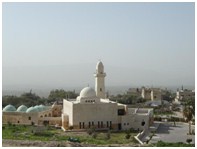
Mu`ath Bin Jabal 
Arabic: معاذ بن جبل), Was a young boy when Mohammad
started preaching the message of Islam. He was a native of Medina and was there during most of Mohammad's
lifetime. He was noted for his intelligence, quick wit, potency in speech, and for his prominent standing between people. He was also described as a very attractive looking individual with dark eyes and eyelashes. His teeth were extremely white and he had an afro. Books referring to his physical appearance say that the onlooker would be stunned by his good looks; He became a Muslim at the hands of Musab bin Umair, Wherever Muath went, people would refer to him for legal judgments on matters over which they differed. This is not strange since he was brought up in the school of the Prophet himself and learnt as much as he could from him. He was the best pupil of the
best teacher. His knowledge bore the stamp of authenticity. The best certificate that he could have received came from the Prophet himself when he said: "The most knowledgeable of my ummah in matters of Halal and haram is Muadh ibn Jabal."
One of the greatest of Muaths contributions to the Moslems was that he was one of the group of six who collected the Quran during the lifetime of the Prophet, peace be upon him, When Muath fell ill with an infectious disease & he was near to death, he turned in the direction of the Kabah and repeated this refrain: "Welcome Death, Welcome. A visitor has come after a long absence . . ." And looking up to heaven, he said: "O Lord, You know that I did not desire the world and to prolong my stay in it . . . O Lord, accept my soul with goodness as you would accept a believing soul..." He died at the age of 38 in the Jordan Valley
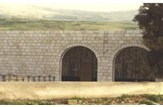
Shurahbil ibn Hasanah 
The venerable companion Shurahbil ibn Hasanah was among the early Muslims who fled to Abyssinia. He was reputed for his strong faith, intelligence, bravery and successful administration. Shurahbil actively participated in the Battle of Yarmouk and the conquest of Jerusalem. When the Caliph Abu Bakr Al-Siddiq sent the Muslim armies to Greater Syria, Shurahbil was in command of the army assigned to the conquest of Jordan. Later, the Caliph Omar ibn Al-Khattab appointed Shurahbil the governor of a province in Greater Syria, where he distinguished himself for his fair dealings with subordinates. He died from the plague on the same day as the venerable companion Abu Ubeida Amer ibn Al-Jarrah.

Amir ibn Abi Waqqas 
The venerable companion Amir ibn Abi Waqqas was the maternal cousin of the Prophet and the 11th man to convert to Islam. He was devoted to his faith, although his mother Himnah, daughter of Abi Sufyan ibn Harb ibn Umayyah, swore to stay out in the burning sun until he renounces Islam. He migrated to Abyssinia and fought in the Battle of Uhud and was later entrusted with carrying messages from the commanders of the Muslim army to the Caliph in Medina. Furthermore, he was the deputy of the venerable companion Abu Ubeida in his governorship of the military district of Syria. You can visit his tomb located inside a new building erected on vaults, within the village of Waqqas in the northern Jordan valley.

Derar ibn Al-Azwar 
The venerable companion Derar ibn Al-Azwar was a poet and a fierce warrior who loved combat. He fought in the wars of Apostasy and took part in the conquest of Greater Syria along with his distinguished sister Khawlah bint Al-Azwar. In the town of Deir Alla a mosque superimposed by a dome houses the tomb of Dirar ibn Al-Azwar. The 18th year after Hijra was when he, too, became a victim of the Great Plague.
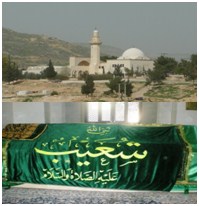
Shrine of Prophet Shu'ayb 'Jethro'
- Salt city (30km North-west Amman)
Shuʿayb, or Shoaib, (Arabic: شعيب; meaning who shows the right path), believed that he was sent as a prophet to two communities, namely the Midianites and the People of the Wood, He is mentioned in the Qur'an a total of 11 times. He is believed to have lived after Abraham, Shoaib proclaimed the faith of Islam and warned the people to end their fraudulent ways. When they did not repent, God destroyed both the communities, Shoaib is understood to have been one of the few Arabian prophets mentioned by name in the Qur'an, the others being Saleh, HUD, Ishmael and Mohammad
. It is said that he was known by early Muslims as "the eloquent preacher amongst the prophets", because he was granted talent and eloquence in his language, his tomb
lies in Salt.
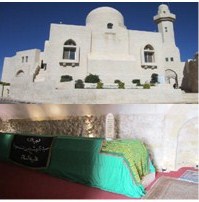
Shrine of Prophet Yusha 'Joshua'
- Salt city (30km North-west Amman)
He was
the second prophet of the Bani-Isra’il, within a mosque to the west of Salt, on a hill carrying his name lies the shrine of Prophet Yusha ‘Joshua’. He was the apprentice of Prophet Moses and later his successor. Prophet Joshua led the army of the tribes of Israel in conquest over the land of Palestine. South-west of Salt in an area known as Khirbet Ayyoub foundations of an ancient building mark the final resting place of Prophet Ayyoub 'Job' who is mentioned in the Holy Qur'an 4 times. His legendary patience and faith gave him strength to endure tremendous hardships. Ultimately Prophet Job was rewarded with blessings, as stated in the Holy Qur'an (Sura 21, verses 83-84): "And (remember) Ayyoub, when He cried to his Lord, 'Truly distress has seized me, but Thou art the Most Merciful of those that are merciful'. So we listened to him: We removed the distress that was on him, and we restored his people to him, and doubled their number, as a Grace from Ourselves, and a thing for commemoration, for all who serve us".
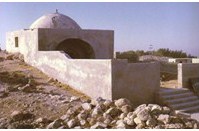
Shrine of Prophet HUD
- Jerash city
The prophet HUD
was an ancient Arab prophet, descended from the prophet Noah. Allah
sent him to his tribe Aad, who were known for their strength and size, and said to live in the Yemen, to warn them to worship one God, but they ridiculed him and accused him of madness. Eventually, Allah
sent them a terrible drought as a warning, and when they did not heed that, he sent a black cloud with a terrible wind that for eight days and seven nights chastised them and eventually destroyed them all, with the exception of HUD and the faithful with him who escaped. The eleventh chapter in the Qor'an was named after him. His shrine is located near Jerash.
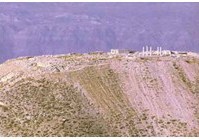
Shrine of Prophet Yahya (John the Baptist)
- Mukawir city
Prophet yahya (John the Baptist) was the son of the prophet Zechariah
and thus also the cousin of the blessed Virgin Mary. His birth itself was miraculous because his parents were too old to have children at the time, but were granted one in response to his father's prayers to Allah
to grant him a son that would carry on his work (of preaching). Yahya
was a pious, ascetic son, and was inspired with the scripture and went about the land preaching the word of God, and foretelling the imminent advent of the Messiah. When consulted by King Herod Antipas as to the illicitness of the latter's marriage, he refused to declare it legal, and was eventually murdered for this, at the instigation of Salome, in Herod's citadel at Mukawir / Machaerus. Albeit his head was taken and buried in what is now the Umayyad mosque in Damascus, while his body remained and buried in Mukawir.
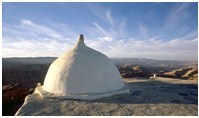
Shrine of Prophet Harun ‘Aaron’
- Petra city
On top of Jabal Al-Nabi Harun near Petra is the shrine of Prophet Harun 'Aaron'
the brother of Prophet Musa 'Moses'
. Allah
responded favorably to the supplication of Prophet Moses
to make Aaron his minister. Prophet Moses
left Aaron
to act on his behalf when he went to interlocutor with Allah
, near Mount Sinai, after he had promised his people to produce them a Torah as their constitution and legal document. Aaron
predeceased Moses
and his shrine's topography corresponds exactly with the traditional Islamic and Biblical accounts of Aaron's
burial.
Jordan host the tombs of many of the Prophet Muhammad’s companions,
Who were martyred and buried there
THE COMPANIONS OF OUR BELOVED PROPHET MUHAMMAD
(Sallallahu Alaihi Wasallam)
- A collection of stones marks the tomb of the venerable companion Maysarah ibn Masrouq Al-Abssi buried west of Salt in the town of Arda. He witnessed the Prophet’s Farewell Pilgrimage and took part in the Battle of Yamamah and the conquest of Greater Syria. In the 20th year after Hijra, he became the commander of an army that successfully attacked the Byzantines, making them the first Muslim army to enter Byzantine lands.
- Not far from Ajloun is the tomb of the venerable companion Ikrimah ibn Abi Jahl marked by a collection of stones. He was one of Prophet Mohammad’s
bitterest enemies until he embraced Islam. Later he distinguished himself by contributing to the spread of Islam. Martyred in the Battle of Yarmouk he also took part in the wars of Apostasy and the conquest of Greater Syria. Also in Ajloun is a shrine for El-Khedr 'St. George’ as well as in Salt, Mahes, Kerak and Bayt Ras (Irbid). St. George is not a prophet but one of Allah's righteous worshippers, servants and a favorite saint. He has many shrines in Jordan as Allah revealed a number of miracles through him as a method of educating people on the merits of servitude to Allah . In the Holy Qur'an, his famous story with Prophet Moses is cited in Surat Al-Kahf (The Cave) (verses 64-82).
- The tomb of the venerable companion Abul-Dardaa is located in a modern building in the village of Soam Ashunnaq near Irbid. One of the most devoted and pious of the companions, he was always by the Prophet’s side. Abul-Dardaa is best known for surpassing everyone else in memorizing, narrating and transmitting Prophet Mohammad’s hadith. He took part in military campaigns and was later appointed governor of the Bahrain province.
- The much beloved venerable companion Jabir ibn Abdullah Al-Ansari has a shrine in Tafilah. He took part in nineteen military campaigns and was beside Prophet Mohammad during the conquest of Mecca.
- On the top of Mount Nebo, the Prophet Musa 'Moses' looked over the Jordan River towards Palestine; it is generally acknowledged that Prophet Moses was buried on Mount Nebo, although there is no actual tomb marking the spot. The Holy Qur'an describes in detail the life and mission of Prophet Moses . In fact, Prophet Moses is the most mentioned prophet in the Holy Qur'an.
Glossary of Islamic terms
Allah: The greatest and most inclusive of the names of God. It is an Arabic word of rich and varied meaning, denoting the one who is adored in worship, who creates all that exists, who has priority over all creation, who is lofty and hidden, who confounds all human understanding. It is exactly the same word as, in Hebrew, the Jews use for God (Eloh), the word which Jesus Christ used in Aramaic when he prayed to God. God has an identical name in Judaism, Christianity and Islam; Allah is the same God worshipped by Muslims, Christians and Jews.
"He is God, the One God, Independent and Sought by all; He begets not, nor is He begotton, and there is none like unto Him." (The Holy Qur'an, Surah Al-Ikhlas)
Sallallahu ‘alaihi wa sallam :
This is an expression that Muslims use whenever the name of Prophet Mohammad (sallallahu ‘alaihi wa sallam.) is mentioned or written. The meaning of it is: “May the blessings and the peace of Allah be upon him (Mohammad). Another expression that is alternatively used is: “Alaihissalatu Wassalam.” This expression means: “On Him (Mohammad) are the blessings and the peace of Allah.” Allah has ordered Muslims, in the Qur’an, to say such an expression. Muslims are informed that if they proclaim such a statement once, Allah will reward them ten times. NOTE: it is better to write out the full wording and not use the abbreviations S.A.W.S, so it is better for you and that you may gain the reward for doing it out of respect.
Peace upon him: is a phrase that practicing Muslims often say after saying (or hearing) the name of one of the Prophets.
May Allah be pleased him:
a phrase that practicing Muslims often say after saying (or hearing) the name of one of Prophet Mohammad’s companions.